This loquat jam recipe is a delicious way to preserve these fragile fruit. It requires just three ingredients and uses less sugar than other recipes.
Be sure to try some of my other low-sugar jam recipes, too!
Working with Loquats
Loquats are a soft yellow fruit that grows in warm regions of the southern United States (and here in Hawai’i). They’re sometimes called a Japanese plum (though they are not at all like plums!). They have a lightly fuzzy skin, like apricots and they are somewhat pear shaped. The fruit is somewhat small, measuring an inch or inch-and-a-half across. Each fruit contains at least one, and up to five shiny brown seeds.
These fruits are soft like apricots and peaches. The skin of loquat can show light brown spots where they rub together on the tree. This may be unsightly, but it’s fine to eat. You do need to watch for small round patches that are browning and possibly showing signs of rot. (Especially true if you’re foraging for loquats, as I do.)
The fruit grows in bunches on a loquat tree; it’s not uncommon to have to discard half of the fruit, due to bird pecks, fruit fly stings, and general decay.
I’ll be honest, processing this plum-sized fruit can be a bit tedious. It took me about an hour to prepare the fruit for making the jam.
5 Easy Steps to Transform Your Pantry!
Ready to switch from store bought to homemade? Let me help you make some changes! Grab my FREE five-part guide to getting started.
The Handcrafted Pantry

Ready to DIY your pantry with more wholesome ingredients? Check out my ebook, The Handcrafted Pantry! Filled with delicious recipes for some of your favorite condiments, snacks, and toppings, it’s the guide you need to start skipping packaged products and embrace homemade.
The Skin
The smooth skin of loquats is edible, though some people find bits of skin objectionable in their jam. It’s possible to peel them, though time consuming. I much prefer leaving them on and using either an immersion blender to process them until they’re really fine or running the fruit pulp through a food mill or fine sieve to capture the skins.
If you wish to peel them, use the method outlined here. Another option would be to juice the fruit to make loquat jelly.
The Seeds
You may see some recipes online for using the seeds. The seeds of loquat contain small amounts of cyanogenetic glycosides, like those of apples, apricots, and almonds, so I send mine out to the compost heap.
Removing the large seeds from the loquat leaves behind a thin membrane. I pull as much of this out as is reasonable, but if some ends up in the jam, it’s not a problem.
The first time I processed loquats, I used a knife to cut the fruit in half, scooping out the seeds and membrane, and removing the blossom end. This method works perfectly fine, but after some experimenting, I’ve found that just using my thumbs to tear the fruit open is quicker.
It’s not glorious and it results in less-than-perfect halves, but you’re just going to smash them anyway.
Loquat Jam
Turning these fruits into homemade jam is easy once you’ve prepared the fruit.
Ingredients
Loquats — You’ll need about four pounds of loquats to make five half-pint jars of loquat jam. The loquats are use are foraged from trees that grow wild. Cultivated loquats are likely a bit larger than the ones I use. Ripe loquats are a golden orange fruit, but beating the birds to the fruit often means harvesting them a little on the lighter yellow side.
Sugar — Use your favorite brand of granulated cane sugar. I prefer organic. If you’d like to use brown sugar for a slightly richer flavor, you can.
Lemon juice: USDA preserving recipes all call for using bottled lemon juice rather than fresh lemon juice. This assures that the acidity level in recipes is safe for canning.
Pectin – This recipe is made using Pomona’s Universal Pectin. This is the only pectin I use anymore as it allows me to use much less sweetener. The standard pectin brands use an obscene amount of sugar in my opinion, often requiring equal amounts of sugar and fruit! This product uses a low methoxyl method and calls for using two different ingredients, which are included in the box: pectin (the large packet) and calcium powder (the small packet). The dry pectin is mixed with the sweetener before being added to the fruit. The calcium water is added directly to the fruit.This reduced sugar recipe is just as delicious and just a bit healthier!
Making the Jam
Once you’ve prepared the fruit, you’ll need to turn it into the pulp needed for the jam recipe. There are two ways to do this.
The easiest is to use a food processor if you have one. Simply pulse the prepared fruit into a coarse pulp.
If you don’t have a food processor, you’ll need to cook the loquat fruit down to create a pulp. Measure the prepared loquat halves or pieces into a large pot with about a half cup of water. Cook on low heat until the fruit is soft and use a potato masher to crush the fruit. (This will add about 30 minutes to the total time necessary.)
Measure four cups of the mashed loquat into a large saucepan along with the lemon juice and calcium water.
Combine the pectin with the sugar, making sure it’s thoroughly combined.
When the mixture reaches a full rolling boil, add the sweetener to the cooking loquat, stirring vigorously for a minute or two to assure that the pectin is well distributed.
Return to a boil and boil for one minute, and remove from heat.
🍅 Safety First!
Canning is an excellent way to preserve food for the pantry, but there are some important safety considerations to keep in mind. The recipes on this site have been made following safe canning procedures by a certified Master Food Preserver.
- Know the difference between water bath canning and pressure canning. Low acid items must be pressure canned for safety.
- Altering ingredients may change the recipe’s pH, posing a safety issue. I highly recommend investing in pH paper to test your products for acidity level when canning. Note: For safe water bath canning, the Hawaii Master Food Preservers suggest a pH of 4.2 or lower in the tropics. In other regions, the recommended pH is 4.6 or lower.
- Use the proper jars and lids. Never reuse lids, with the exception of the Tattler or Harvest Right hard plastic lids that are intended for such a purpose.
- For more on canning equipment, please go here.
- Want to learn more? The National Center for Home Food Preservation is the go-to resource for safe canning information.
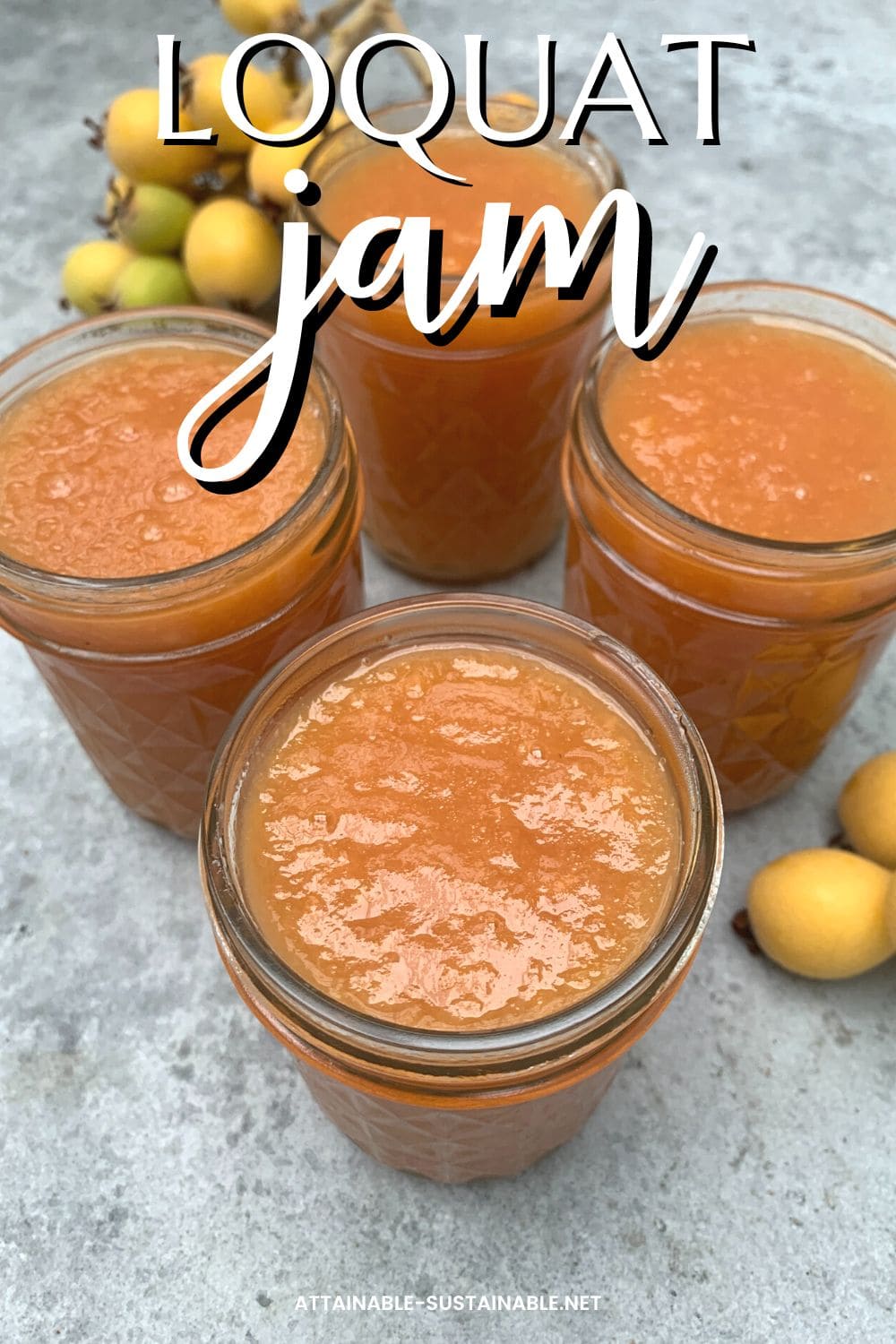
Canning the Jam
You’ll need special canning jars, lids, and rings to make this a shelf-stable product, but the process isn’t difficult.
Transfer hot jam into clean jars, leaving a quarter-inch headspace. Use a non-metallic knife or bubble tool to remove any air bubbles.
Wipe the rims of the jars, removing any residue. Place the lids on and process them in a water bath canner. What this means is you’ll put the filled and sealed jars of jam into hot water and boil them for ten minutes. This assures that the jars will seal well and kills off any potential bacteria in the jam mixture itself.
Use a jar lifter to remove the hot jars to a towel-covered countertop and allow to cool fully. As they cool, you’ll hear the popping sound of the jars sealing. Store any unsealed jars in the fridge and use those first. (This is unusual, but it does happen once in awhile.)
Remove the ring from each sealed jar of loquat jam, rinse to remove any jam residue, and store (without the ring) at room temperature in a dark place such as the pantry. Opened jars should be kept refrigerated; they’ll last in the fridge for several weeks.
★ Did you love this recipe? Be sure to give it a star rating below! ★
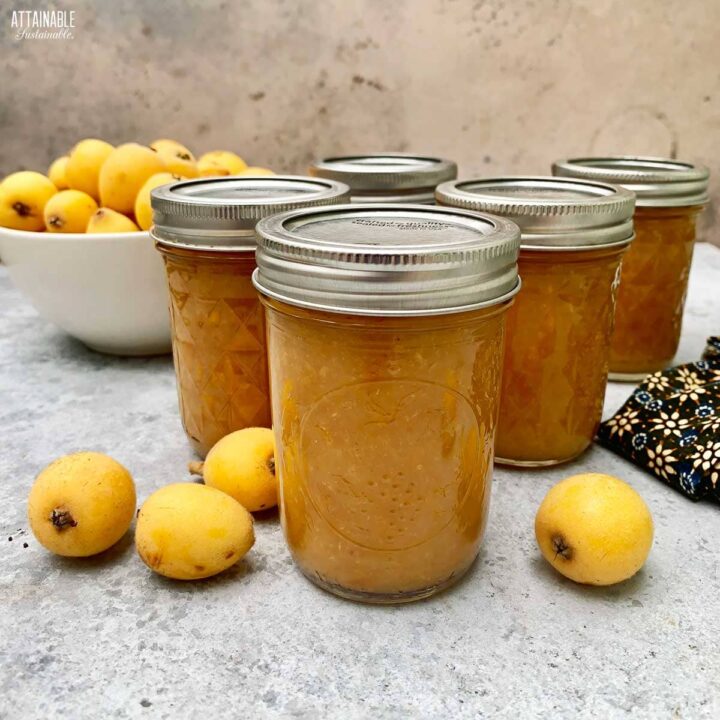
Loquat Jam
It's not likely you'll find this delicious jam at grocery stores! Making loquat jam at home allows you to turn this unique fruit into a flavorful fruit spread.
Ingredients
- 10 cups loquats, seeds removed (about 4 pounds)
- 4 teaspoons calcium water (from Pomona's Universal Pectin box)
- 2 tablespoons lemon juice (bottled)
- 1-1/2 cups granulated sugar
- 1 tablespoon pectin (from Pomona's Universal Pectin box)
Instructions
PREP FOR CANNING
- Prepare the calcium water: Combine ½ teaspoon calcium powder (from the small packet in the box of Pomona’s pectin) with ½ cup water in a small jar. Screw on a lit and shake until well-combined. You'll have more than you need for this recipe. Store the excess in the refrigerator for use in making additional jam or jelly recipes.
- Wash the jars you'll use in hot soapy water, making sure clean jars are free of nicks in the rim, which could impede sealing.
- Wash the lids and rings in hot soapy water. (If you're using non-Ball brand lids, prepare as suggested by manufacturer.)
- Place empty jars in a canning pot with enough water to cover by an inch or two, cover pot, and set on high heat. It can take awhile for the water to heat, so get it started before you begin making the recipe.
MAKE THE JAM
- Wash and dry loquats; remove the seeds, seed membrane, and blossom end of the fruit using a paring knife or simply your fingers.
- Process loquat pieces in a food processor to make a pulp. Alternatively, cook the loquat fruit down to create a pulp. Put the prepared loquat halves or pieces into a pot with about a half cup of water. Cook on low to medium heat until the fruit is soft and mashable.
- Measure 4 cups of loquat pulp into a large saucepan with the lemon juice and calcium water, and bring to a full boil over medium-high heat.
- Meanwhile, in a separate bowl, combine the sugar with 1 tablespoon pectin powder (the large envelope) until thoroughly combined.
- Bring mashed loquats to a full boil. Add sugar mixture, stirring vigorously for a couple of minutes to dissolve the pectin. Return to a boil, boil for one minute, and remove from heat.
CANNING THE JAM
- Remove the empty jars from the canner, draining the water back into the pot.
- Ladle hot jam into half-pint jars to within a quarter inch of the rim. A canning funnel makes this easy.
- Wipe jar rims to remove any jam that may have spilled. A clean rim is essential to a good seal.
- Set jar lids in place. Screw bands on finger tight.
- Use canning tongs to gently submerge jars into the hot water bath. Be sure to place a wire jar rack in the bottom of the pot to prevent the jars of peach jam from sitting directly on the bottom. Water should cover the top of the jars by an inch or two. The water will cool somewhat in reaction to the addition of the jars. Return the water to a low boil and then set the timer.
- Process in a boiling water bath for 10 minutes. Add a minute to the boiling time for every 1,000' above sea level.
- Remove jars to a sturdy surface covered with a dish towel and allow to cool.
- Check seals. Lids should be solid and pulled down tight. (if they flex and pop, the jar didn’t seal; put unsealed jars in the refrigerator and use those first).
- Remove rings and wash outsides of jars. Store in a cool, dry place.
Notes
Finished product tested at 3.0pH, making it safe for the water bath canning method.
Boiling lids or heating above 180°F as once recommended can damage the sealing compound.
SOURCE: Adapted from Pomona's Universal Pectin "create your own" method.
Nutrition Information:
Yield: 40 Serving Size: 2 tablespoonsAmount Per Serving: Calories: 57Total Fat: 0gSaturated Fat: 0gTrans Fat: 0gUnsaturated Fat: 0gCholesterol: 0mgSodium: 1mgCarbohydrates: 15gFiber: 1gSugar: 10gProtein: 0g
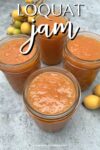
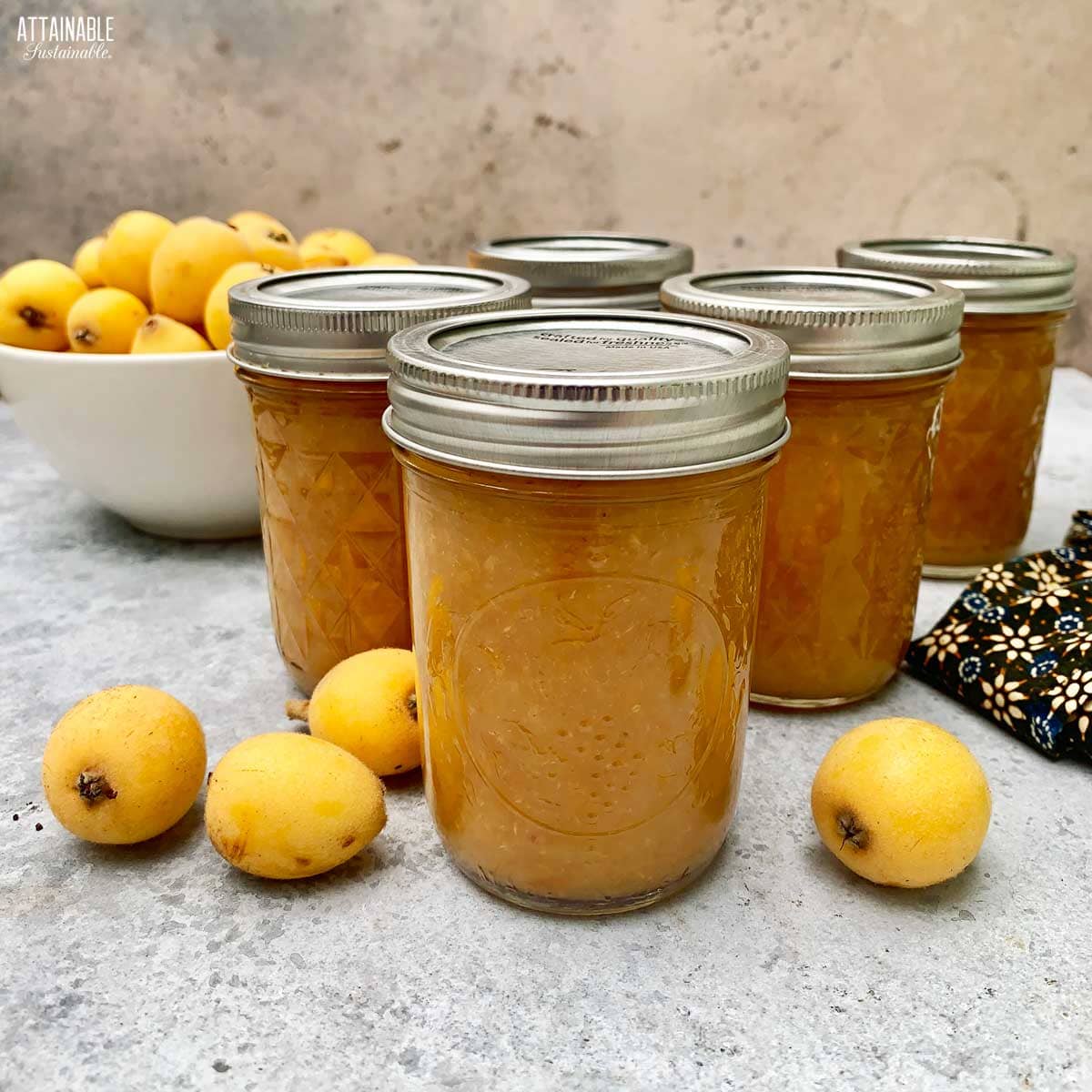
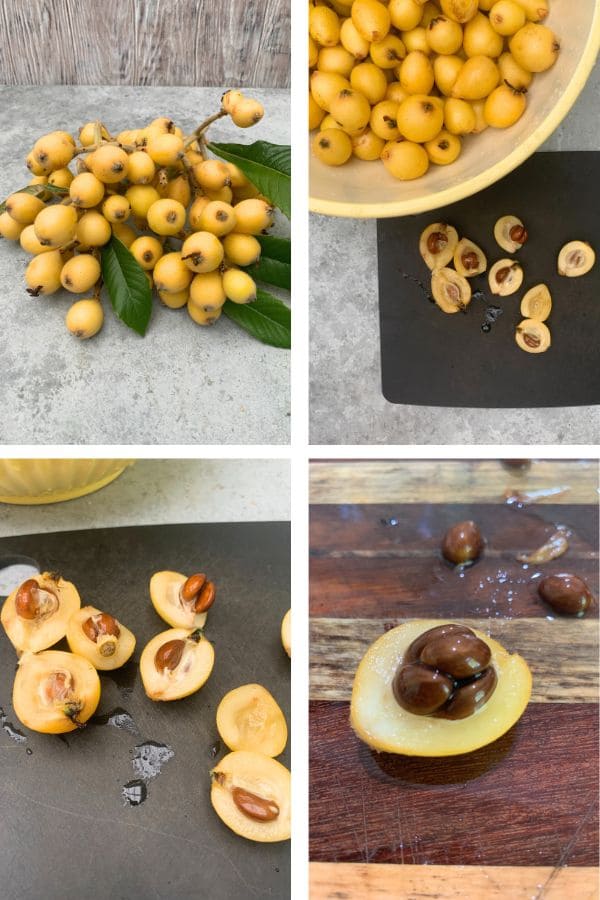
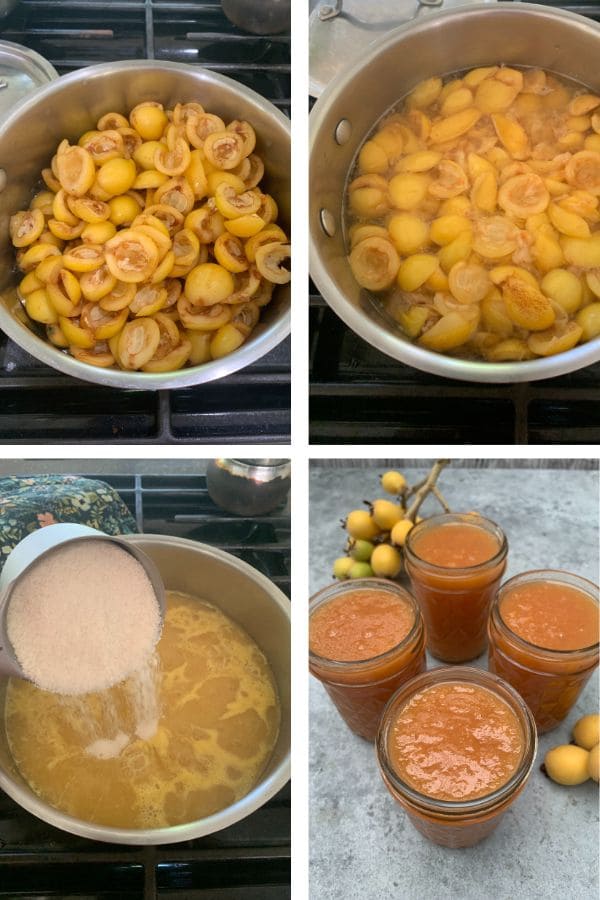






I found I don’t work quickly enoug and the fruit starts to brown. Solution was to dip the halves in the lemon juice needed for processing. Fruit retained beautiful color.
Perfect!